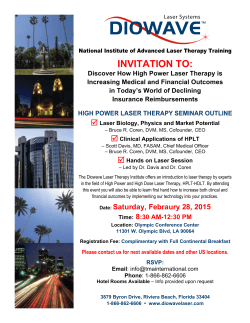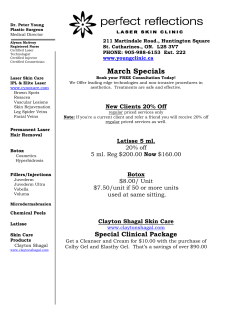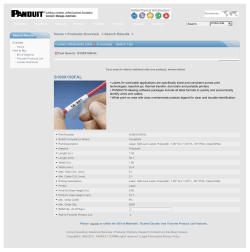
Machine Control â Working Smarter
Machine Control – Working Smarter 1 Global Survey Update Recently employed full-time tech support specialist Martin Drabble B. Surv Surveyor with extensive experience in NZ and overseas Recently awarded NZ’s largest ever 3D machine control order. 35 machines to be fitted. DrillRigs, Dozers, Excavators, Trucks, Site vehicles …. Full real-time fleet management and material tracking Chosen after 6-12 month evaluation. Features Local Service and Support Overview What is Machine Control? Machine Control vs. Machine Guidance Why use Machine Control? Machine Control Solutions Positioning Technology 2D versus 3D New Zealand Examples Productivity Analysis What is Machine Control? Machine Control is: The use of GPS, Total Stations or Lasers technology to guide or control agricultural, construction and mining machinery. Accurately guiding, positioning or controlling the machine can significantly improve accuracy, and productivity as well as reducing operational costs. Machine Control vs. Machine Guidance Machine Guidance Machine Control Visual Indication for the operator Full Hydraulic Control Operator machine. Machine Types fully Machine Types: Dozers, Excavators, Scrapers …. controls the Graders, Dozers, Pavers , Scrapers Scoops / BoxBlades Milling machines…. Why Machine Control? - Market Drivers Higher productivity and performance – profitability. Reduced Costs Significant time savings Savings in Fuel and Emissions, Lower machine hours with less idle time, Reduction in labour content Minimise re-work. Higher accuracy with less material wastage. Closer adherence to specifications. Operator retention – ease of use, flexibility “Positioning Systems” used in machine control. Grade Control Lasers and Sensors Rugged rotating laser systems used to determine height or depth. Options for single and dual grades Total Stations (TPS) Combination of angle and distance measuring system used to accurately measure position in 3 dimensions. Robotic instruments will automatically follow the prism / reflector. Accurate to 2-3mm at 300m. Global Positioning Systems (GPS/GNSS) Using the GPS satellite system for high precision measurements in 3 dimensions. Accurate to approx 1cm. On Machine Sensors and Systems Combination of angle, rotation and slope sensors used to measure the geometry of the machine. Sonic and laser sensors can be used to measure to a physical reference (kerb, stringline) or laser beam. Can be used to control slope (grader / dozer) Hydraulic control or electric over hydraulic Basic Solutions – 2D Machine Control and Guidance Guidance or control provided in a single plane Can be used with positioning systems Cross-Slope control Usually use a rotating laser to establish the reference plane Slopes can be handled by setting the laser into the plane of the slope Stringlines are used for Horizontal Alignment No Slope Single Slope Dual Slope Indicator Rotating Laser Reference Required Depth Excavating using laser positioning 2D System Examples Excavator Set a depth below a peg to dig from. Enter X and Y slopes and dig to grade. Avoid over-cuts etc. E.g. Trenching, Siteworks, Batters …. Grader Control Cross-slope Control Height - work relative to a laser, stringline, kerbline E.g. Road Construction, Siteworks and general grading. Cut to grade quickly and accurately. Depth and Cable Avoidance The operator establishes a known reference point, sets the desired depth and slope, then starts digging. The display panel and lightbar guide the operator to grade. 2D System Examples Dozer Guidance or Control Typically laser control Accuracy 5-10mm Dragscoop / Boxblade Single or dual laser control Typical accuracy 5-10mm Used for floor slab preparation, siteworks … Bodley Bros. Before Typically 3 Staff One Dozer operator, one roller operator, one grade checker Finish 200 m2 per day Accuracy 10-20mm Fitted dual laser hydraulic control After Typically one operator Finishing 1000 – 1300 m2 per day Accuracy 5mm 500% Productivity improvement with less staff, less fuel and machine time and higher accuracy. Summary - 2D System Capability What can I do with a 2D system ? Control Cross-slope, height …. Work relative to a reference e.g. laser, kerbline (sonic), peg or stake. Works well with simple designs. What can’t I do ? Work with complex designs containing changing super-elevation, vertical curves ….. What do I need? 2D control or guidance system fitted to your machine Optional Laser / Sonic sensors Paper plans of the design 3D Solutions Guidance or control against a design shape Compares Position of the blade or bucket to the 3D design. Uses GPS or Total Station (TPS) positioning, depending on location and required finish accuracy GPS Vertical accuracy TPS (robotics) Vertical accuracy +/- 10-20 mm +/- 5mm Removes the need for stakeout and grade checking – lower survey costs. Usually requires a Digital Terrain Model (DTM) or design lines loaded on the machine. Handles very complex designs and shapes. What do you need ? 3 parts required 2D hydraulic control or guidance Positioning system (TPS/GPS) 3D computer and software. 3D systems are scaleable Can start out with entry level 2D system and upgrade. Transferable between machines. Each of the 3 parts is useful on its own. Electronic Data Exchange 3D Electronic Data is uploaded into the machine. Advantages of Electronic Interchange Avoid errors Allows better utilisation of technology for the benefit of all parties (consultant, contractor and client) Need to work with design consultants to get datasets electronically. 3D Machine Control Types of 3D Machine Control Systems Machine Guidance Operator is guided to grade Typically using GNSS earthworking machinery for Dozers, Excavators, Scrapers, Rollers ….. Machine Control Full Hydraulic Control Typically used machines for finer finishing Graders, Pavers, Trimmers, Dozers …… Typical Accuracy TPS Grader (total station) = approx +/- 5mm GNSS Grader = +/- 10-20mm 3D Machine control Advantages: No need for pegging and staking Better adherence to design and shape – not just right at pegs Higher ride quality Pavement can be constructed in even layers avoiding any differential compaction. Significant savings in time, materials and costs Fewer passes when aggregate segregation grading minimises Case Studies – Stringfellows (Palmerston North) Small – Medium sized civil contractor Roading and subdivisional work Ap[prox 20 staff 3D Machine Control system on CAT 130G motorgrader Robotic Total station controlled Purchased second robotic for Survey work Purchased GPS system for bulk earthworks Purchased 2D Excavator (x2) for trenching, batters and general excavator level control The Results Getting about 5mm height accuracy with grader. Don’t have additional staff grade-checking More time on machinery Lower fuel and machine hours I’ve been grading for over 20 years. The 3km of road we did recently with the Leica system is the best road I’ve ever built and took about half the time. - Kim (Grader operator) Case Studies – Goodman Contractors (Wellington) Project: 8km re-alignment at Kaitoke (between Masterton) over Rimutaka ranges Subcontractor to Higgins Client – Transit NZ Wellington and GPS 3D Machine Control system on CAT 16G motorgrader The Result Getting about 10mm accuracy on a steep job. Significant issues with poor weather on the job Using the system allowed Goodmans to achieve significantly higher production rates when the weather was good. “Normally to do a 1m cut for 1km of subgrade takes us about 15 days. With the Leica system we did it in 4.5 days with less people and less gear.” - Stan Goodman 3D Machine Control Video
© Copyright 2025









